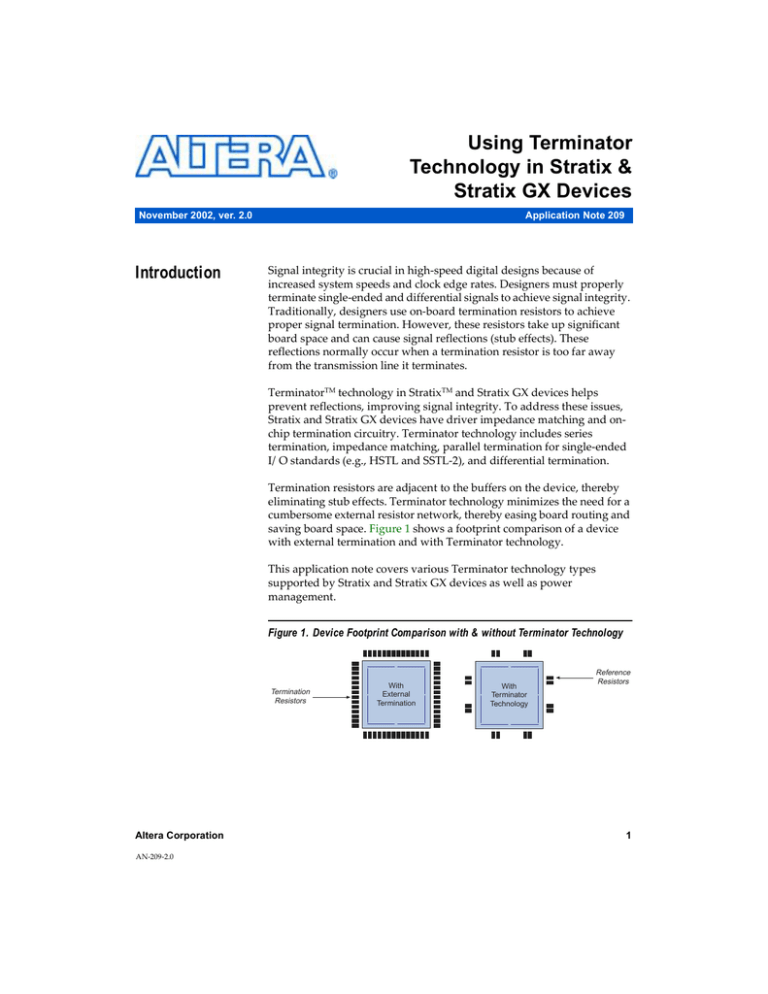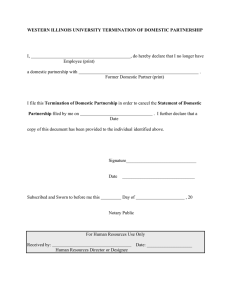
Using Terminator
Technology in Stratix &
Stratix GX Devices
November 2002, ver. 2.0
Introduction
Application Note 209
Signal integrity is crucial in high-speed digital designs because of
increased system speeds and clock edge rates. Designers must properly
terminate single-ended and differential signals to achieve signal integrity.
Traditionally, designers use on-board termination resistors to achieve
proper signal termination. However, these resistors take up significant
board space and can cause signal reflections (stub effects). These
reflections normally occur when a termination resistor is too far away
from the transmission line it terminates.
TerminatorTM technology in StratixTM and Stratix GX devices helps
prevent reflections, improving signal integrity. To address these issues,
Stratix and Stratix GX devices have driver impedance matching and onchip termination circuitry. Terminator technology includes series
termination, impedance matching, parallel termination for single-ended
I/O standards (e.g., HSTL and SSTL-2), and differential termination.
Termination resistors are adjacent to the buffers on the device, thereby
eliminating stub effects. Terminator technology minimizes the need for a
cumbersome external resistor network, thereby easing board routing and
saving board space. Figure 1 shows a footprint comparison of a device
with external termination and with Terminator technology.
This application note covers various Terminator technology types
supported by Stratix and Stratix GX devices as well as power
management.
Figure 1. Device Footprint Comparison with & without Terminator Technology
Termination
Resistors
Altera Corporation
AN-209-2.0
With
External
Termination
With
Terminator
Technology
Reference
Resistors
1
AN 209: Using Terminator Technology in Stratix & Stratix GX Devices
How Terminator
Technology
Works
Two external precision resistors (RUP and RDN ) per VCCIO bank are used
as reference resistors. RUP is a pull-up resistor connected to VCCIO; RDN is
a pull-down resistor connected to GND. Terminator technology monitors
the value of the two reference resistors and uses the value to adjust
internal termination circuitry to the same impedance. In addition,
Terminator technology circuitry compensates for voltage, temperature,
and process variation. This circuitry continuously calibrates the internal
termination resistors during normal device operation.
Terminator technology supports one type of I/O standard per I/O bank.
You can enable or disable on-chip termination within an I/O bank on a
pin-by-pin basis. To use different on-chip termination I/O standards on a
device, select separate I/O banks. For example, if you want to use on-chip
termination for GTL+ (3.3-V VCCIO ) and SSTL-3 class II (3.3-V VCCIO ), use
two separate I/O banks.
Different I/O standards need different VCCIO and VREF voltages. You can
simultaneously use some I/O standards with the same VCCIO in an I/O
bank. For more information, refer to AN 201: Using Selectable I/O Standards
in Stratix Devices.
Series
Termination
Resistor (RS)
Terminator technology provides an on-chip series termination resistor
(RS) for single-ended voltage-referenced I/O standard such as SSTL-2 and
SSTL-3. The series termination value for these I/O standards is 25 Ω; the
impedance matching value for these I/O standards is either 25 or 50 Ω. All
I/O pins in Stratix and Stratix GX devices support this termination
method. Table 1 shows the I/O standards supported for series
termination and impedance matching.
Table 1. Supported I/O Standards for Series Termination & Impedance Matching
Feature
Series Termination
Impedance Matching
2
Supported I/O Standards
SSTL-3 class I
VCCIO (V)
3.3
SSTL-3 class II
3.3
SSTL-2 class I
2.5
SSTL-2 class II
2.5
LVTTL/LVCMOS
3.3
LVTTL/LVCMOS
2.5
LVTTL/LVCMOS
1.8
Altera Corporation
AN 209: Using Terminator Technology in Stratix & Stratix GX Devices
Impedance Matching
The impedance of the output driver is matched with the transmission line
impedance. Stratix and Stratix GX output buffers can match output
impedance to either 25 or 50 Ω. This impedance matching results in
properly terminated signals, improving signal integrity. This feature is
supported by all Stratix device I/O pins.
1
When using impedance matching for an output buffer, variable
drive current strength and slow-slew rate features are not
available.
Figure 2 shows the on-chip impedance matching resistor for an output
driver.
Figure 2. Driver Impedance Matching
Impedance Matched
Driver (LVTTL, LVCMOS)
Receiving Buffer
(LVTTL, LVCMOS)
VCCIO = 1.8, 2.5, or 3.3 V
Rs
Z0
Parallel
Termination
(RT)
Altera Corporation
Terminator technology supports on-chip parallel termination for several
voltage-referenced I/O standards. To maintain signal integrity and save
board space, use Terminator technology resistors instead of external pullup termination resistors. Parallel termination is supported for SSTL-2,
SSTL-3, HSTL (class I and II), GTL, GTL+, and CTT I/O standards. All the
I/O pins in the top and bottom I/O banks support parallel termination.
Figure 3 shows the parallel termination connections for a Stratix device.
3
AN 209: Using Terminator Technology in Stratix & Stratix GX Devices
Figure 3. Terminator Technology Parallel Termination
Driver with Parallel
Termination
Receiver with Terminator
Technology Parallel Termination
VTT
VTT
R
R T2
T1
Z0
VREF
Table 2 shows the supported I/O standards for parallel termination in
Stratix and Stratix GX devices.
Table 2. Supported I/O Standards for Parallel Termination
Supported I/O
Standards
Parallel
Termination
(RT1)
Parallel
Termination
(RT2)
VCCIO (V)
SSTL-3 class I
N/A
50 Ω
3.3
SSTL-3 class II (1)
50 Ω
50 Ω
3.3
SSTL-2 class I
N/A
50 Ω
2.5
SSTL-2 class II (1)
50 Ω
50 Ω
2.5
HSTL class I
N/A
50 Ω
1.5
HSTL class II
50 Ω
50 Ω
1.5
GTL
50 Ω
50 Ω
3.3
GTL+
50 Ω
50 Ω
3.3
CTT
N/A
50 Ω
3.3
Note to Table 2:
(1)
4
In addition to parallel termination, SSTL-3 and SSTL-2 class II I/O standards
require a series termination next to the output buffer. If you are using these I/O
standards for the output pins, Altera recommends using the on-chip series
termination and an external pull-up resistor to VTT for parallel termination.
Figure 4 shows the connection scheme for these particular I/O standards.
Altera Corporation
AN 209: Using Terminator Technology in Stratix & Stratix GX Devices
Figure 4. Terminator Technology Series-Parallel Termination
External Resistor
Provided by User
Driver with Series
Termination
Receiver with Terminator
Technology Parallel Termination
VTT
VTT
R
R
R T2
T1
S
Z0
VREF
Differential
Termination
(RD)
Terminator technology supports on-chip differential termination for
source-synchronous LVDS signalling. The differential termination
resistors are adjacent to the differential input buffers on the device. This
placement eliminates stub effects, improving the signal integrity of the
serial link. Using on-chip differential termination resistors also saves
board space. Figure 5 shows the differential termination connections for
Stratix and Stratix GX devices.
Figure 5. Terminator Technology Differential Termination
Differential
Transmitter
Differential Receiver with
Terminator Technology
LVDS Termination
Z0
RD
Z0
Differential termination for Stratix devices is supported for the left and
right I/O banks. Differential termination for Stratix GX devices is
supported for the left, source-synchronous I/O bank. Some of the clock
input pins are in the top and bottom I/O banks, which do not support
differential termination. External reference resistors are not required for
I/O banks that support differential termination. The value of on-chip
differential termination resistors is 100 Ω.
Altera Corporation
5
AN 209: Using Terminator Technology in Stratix & Stratix GX Devices
Transceiver
Termination
f
Reference
Resistors
Stratix GX devices feature built-in on-chip termination within the
transceiver at both the transmit and receive buffers. This termination
improves signal integrity and provides support for the 1.5-V PCML I/O
standard.
See AN 237: Using High-Speed Transceiver Blocks in Stratix GX Devices for
more information on transceiver termination.
Connect the two reference resistors (RUP and RDN ) to the two dualpurpose reference pins per I/O bank. RUP is a pull-up resistor and is
connected to the VCCIO of that I/O bank. RDN is a pull-down resistor and
is connected to GND of that I/O bank. Figure 6 below shows the reference
resistor connections.
Figure 6. Terminator Reference Resistor Connections
VCCIO
R
UP
Device
R
DN
GND
Table 3 shows the external reference resistor values for different types of
terminations.
Table 3. External Reference Resistance Values
Termination Type
Impedance (Ω)
Note (1)
RUP/RDN
25
10 × Z0
50
10 × Z0
Series Termination
25
10 × Z0
Parallel Termination
50
20 × Z0
100
Not needed
Impedance Matching
Differential Termination
Note to Table 3:
(1)
6
Z0 is the target on-chip impedance.
Altera Corporation
AN 209: Using Terminator Technology in Stratix & Stratix GX Devices
Power Analysis
Terminator technology on-chip termination resistors increase the total
current draw of the device. This increase in current draw occurs because
the termination circuitry, which is normally external to the device, is now
a part of the device. Make sure the device’s current consumption in a
design does not exceed any device limits. You must ensure that no more
than 200 mA (Flip Chip packages) is consumed for any ten consecutive
I/O pins (excluding VCC and GND pins). The Altera® Quartus® II software
automatically performs these calculations during compilation. If the pin
assignments do not comply with these conditions, the Quartus II software
generates an error message during design compilation.
Table 4 lists the DC current draw when using on-chip series termination
for single-ended I/O standards.
Table 4. DC Current Draw for On-Chip Series Termination
Bank I/O Standard Selected by
Terminator Technology
DC Current Draw per
Pin for Series
Termination
(Ipin in mA) (1)
VCCIO (V)
LVTTL
0
1.8, 2.5, 3.3
LVCMOS
0
1.8, 2.5, 3.3
SSTL-2 class I
10
2.5
SSTL-2 class II
23
2.5
SSTL-3 class I
11
3.3
SSTL-3 class II
24
3.3
Note to Table 4:
(1)
Altera Corporation
Ipin is the DC current drawn per pin.
7
AN 209: Using Terminator Technology in Stratix & Stratix GX Devices
Table 5 lists the DC current draw when using Terminator technology onchip parallel termination resistors for single-ended inputs or outputs.
Table 5. DC Current Draw for On-Chip Series-Parallel Termination (Input & Output Pins)
Note (1)
Bank I/O Standard
Selected by Terminator
Technology
VCCIO (V)
DC Current Draw per Pin for Series & Parallel Termination
(Ipin in mA) (2)
Output Mode
Input Mode
RS
RT1 (3)
GTL
N/A
40
RT2 (3)
15
3.3
GTL+
N/A
34
14
3.3
SSTL-2 class I
10
N/A
12
2.5
SSTL-2 class II
23
N/A
12
2.5
SSTL-3 class I
11
N/A
15
3.3
SSTL-3 class II
24
N/A
17
3.3
CTT
N/A
N/A (4)
18
3.3
HSTL class I
N/A
N/A (4)
9
1.5
HSTL class II
N/A
20
10
1.5
Notes to Table 5:
(1)
(2)
(3)
(4)
8
There are no current limitations for 1.8-V I/O standards (thermally-enhanced ball-grid array (BGA) cavity-up
packages).
Ipin is the DC current drawn per pin.
RT1 and RT2 are the parallel termination resistors for the voltage-referenced I/O standards. RT1is the parallel
termination resistor next to the output buffer and RT2 is the parallel termination resistor next to the input buffer. See
Figure 3.
The CTT output buffer and HSTL Class I output buffer do not draw any current due to the on-chip termination
resistor for single-ended I/O pins, but they will still draw 8 mA as specified in the corresponding JEDEC
specifications.
Altera Corporation
AN 209: Using Terminator Technology in Stratix & Stratix GX Devices
When using bidirectional pins, the total DC current draw by Terminator
technology on-chip termination resistors is different than the values listed
in Table 5. Table 6 lists the DC current draw values for bidirectional pins.
Table 6. DC Current Draw for On-Chip Series-Parallel Termination (Bidirectional Pins)
Bank I/O Standard
Selected by Terminator
Technology
DC Current Draw per Pin for Series & Parallel Termination
(Ipin in mA) (2)
Note (1)
VCCIO (V)
RS
RT1 (3)
GTL
N/A
40
40
3.3
GTL+
N/A
34
34
3.3
SSTL-3 class I
11
N/A
25
3.3
SSTL-3 class II
24
N/A
37
3.3
SSTL-2 class I
10
N/A
19
2.5
SSTL-2 class II
23
N/A
25
2.5
N/A
N/A (4)
27
3.3
HSTL class I
N/A
N/A (4)
16
1.5
HSTL class II
N/A
20
20
1.5
CTT
RT2 (3)
Notes to Table 6:
(1)
(2)
(3)
(4)
There are no current limitations for 1.5- and 1.8-V VCCIO I/O standards.
Ipin is the DC current drawn per pin.
RT1 and RT2 are the parallel termination resistors for the voltage referenced I/O standards. RT1 is the parallel
termination resistor next to output buffer and RT2 is the parallel termination resistor next to input buffer.
The CTT output buffer and HSTL class I output buffer do not draw any current due to the on-chip termination
resistor for single-ended I/O pins, but they will still draw 8 mA as specified in the corresponding JEDEC
specifications.
Altera Corporation
9
AN 209: Using Terminator Technology in Stratix & Stratix GX Devices
When you enable Terminator technology for an I/O bank, the external
reference resistors for that bank are activated. When enabled, these
reference resistors also draw a finite amount of current. The current
consumption of these resistors for different I/O standards is shown in the
Table 7.
Table 7. RUP & RDN Current Consumption
Bank I/O Standard
Selected by Terminator
Technology
Note (1)
RUP & RDN Current Consumption
per I/O Bank (Iref in mA) (2)
Series
Termination
VCCIO (V)
Parallel
Termination
LVTTL/LVCMOS (3)
16
N/A
3.3
LVTTL/LVCMOS (3)
10
N/A
2.5
SSTL-2 class I
9
13
2.5
SSTL-2 class II
12
14
2.5
SSTL-3 class I
15
22
3.3
SSTL-3 class II
19
26
3.3
HSTL class I
N/A
5
1.5
HSTL class II
N/A
5
1.5
GTL
N/A
17
3.3
GTL+
N/A
17
3.3
CTT
N/A
24
3.3
Notes to Table 7:
(1)
(2)
(3)
There are no current restrictions for the HSTL class I and class II I/O standards
(thermally-enhanced BGA cavity-up packages).
Iref is the current drawn by the Terminator technology control circuitry, including
the external reference resistors RUP and RDN, per I/O bank.
These values are the same whether you are using 250- or 500-Ω reference resistors.
Dual-purpose pins for connecting external reference resistors are also
included while counting ten consecutive I/O pins. When using
Terminator technology, Figure 7 shows a Stratix or Stratix GX device’s
current draw limitation guidelines.
f
10
For complete details on the current draw limits or any other limitations for
different I/O standards, refer to AN 201: Using Selectable I/O Standards in
Stratix Devices.
Altera Corporation
AN 209: Using Terminator Technology in Stratix & Stratix GX Devices
Figure 7. Current Draw Limitation Guidelines Using Terminator Technology
I/O Pin Sequence
of an I/O Bank
VCC
Any 10 Consecutive I/O Pins,
Excluding either RUP or RDN
or Both
GND
VCC
R
UP
R
DN
Any 10 Consecutive I/O Pins,
Including either RUP or RDN
or Both
GND
VCC
If the ten consecutive I/O pins exclude either RUP or RDN or both pins, the
current draw limitations in thermally enhanced BGA packages cannot
exceed 200 mA. Consult Altera Applications for current draw limit for all
other packages.
Altera Corporation
11
AN 209: Using Terminator Technology in Stratix & Stratix GX Devices
For example, consider a case where the ten consecutive pins are
configured as follows (only seven of the ten pins are used in this example):
■
■
Number of SSTL-3 Class I output pins with Terminator
technology = 3
Number of GTL+ output pins without Terminator technology = 4
In this case, the total current draw for these ten consecutive I/O pins
would be (see Tables 5 and 6 for values):
(# of SSTL-3 Class I pins with Terminator technology × 11 mA) +
(# of GTL+ output pins × 34 mA) = (3 × 11 mA) + (4 × 34 mA) = 169 mA
In the above example, the total current draw for all ten consecutive I/O
pins is less than 200 mA.
If the ten consecutive I/O pins also include either RUP or RDN or both pins,
the current draw limitation for Stratix devices should be less than
(200 mA - Iref), where Iref is the current drawn by either RUP or RDN or
both.
For example, consider another case where the ten consecutive pins are
configured as follows (nine of the ten pins are used in this example):
■
■
Number of SSTL-3 Class II output pins with Terminator
technology = 8
Number of external reference resistor pins (RUP and RDN) = 1
In this case, the sum total of current draw for these ten consecutive I/O
pins would be (see Tables 4 and 7 for values):
(# of SSTL-3 Class II output pins with Terminator technology × 25 mA) +
(total current due to the Terminator technology, including external
reference resistor pins RUP and RDN) = (8 × 24 mA) + (26 mA) = 218 mA
In the above example, the total current draw for all ten consecutive I/O
pins is more than 200 mA. Therefore, this case is not allowed and the
Quartus II software generates an error message during design
compilation.
12
Altera Corporation
AN 209: Using Terminator Technology in Stratix & Stratix GX Devices
Design Tips
The following is a list of design tips:
■
■
■
■
■
■
■
■
■
■
Parallel termination is supported only on the top and bottom I/O
banks.
Series termination and impedance matching is supported on all the
I/O banks.
Differential termination is supported only on the left and right I/O
banks in Stratix devices and on the left I/O bank in Stratix GX
devices.
Transceiver termination is supported in the Stratix GX transceiver.
Terminator technology supports one type of on-chip termination I/O
standard for a given I/O bank.
Some features, such as LVTTL variable drive strength and slow slew
rate control, cannot be used when impedance matching is enabled.
Each I/O bank has two dual-purpose reference pins to which two
external reference resistors need to be connected when using
Terminator technology.
Each I/O pin can either support series or parallel termination. In the
case of SSTL-2 class II and SSTL-3 class II output pins, Altera
recommends using on-chip series termination and parallel external
pull-up resistors.
There are no current draw limitations for 1.8-V VCCIO levels
(thermally-enhanced BGA cavity up packages).
Total current draw of ten consecutive I/O pins, including two dualpurpose pins for external reference resistors within these ten I/O
pins, should not exceed 200 mA (thermally-enhanced BGA cavity up
packages).
Conclusion
Increasing clock speeds and faster edge rates have made board design
challenging. Designers must ensure that signal traces on the board are
properly terminated to maintain signal integrity. Altera’s Stratix and
Stratix GX device families with Terminator technology offers impedance
matching and on-chip termination resistors for single-ended and
differential I/O standards. Terminator technology enables designers to
meet signal integrity requirements while simplifying board design,
saving time and resources.
Revision
History
The information contained in AN 209: Using Terminator Technology in
Stratix & Stratix GX Devices version 2.0 supersedes information published
in previous versions. The following changes were made in AN 209: Using
Terminator Technology in Stratix & Stratix GX Devices version 2.0
■
■
■
Altera Corporation
Added Stratix GX devices throughout the document.
Added Note (1) to Table 3.
Added Note (3) to Table 7.
13
AN 209: Using Terminator Technology in Stratix & Stratix GX Devices
101 Innovation Drive
San Jose, CA 95134
(408) 544-7000
http://www.altera.com
Applications Hotline:
(800) 800-EPLD
Literature Services:
lit_req@altera.com
14
Copyright © 2002 Altera Corporation. All rights reserved. Altera, The Programmable Solutions Company, the
stylized Altera logo, specific device designations, and all other words and logos that are identified as
trademarks and/or service marks are, unless noted otherwise, the trademarks and service marks of Altera
Corporation in the U.S. and other countries. All other product or service names are the property of their
respective holders. Altera products are protected under numerous U.S. and foreign patents and pending
applications, maskwork rights, and copyrights. Altera warrants performance of its
semiconductor products to current specifications in accordance with Altera's standard
warranty, but reserves the right to make changes to any products and services at any time
without notice. Altera assumes no responsibility or liability arising out of the application
or use of any information, product, or service described herein except as expressly agreed
to in writing by Altera Corporation. Altera customers are advised to obtain the latest
version of device specifications before relying on any published information and before
placing orders for products or services.
Altera Corporation



